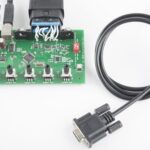Understanding your car’s diagnostic trouble codes (DTCs) is crucial for effective vehicle maintenance and repair. When your car’s check engine light illuminates, it’s signaling that the onboard diagnostics system (OBD2) has detected an issue. An OBD2 scanner can retrieve these codes, providing valuable insights into potential problems. This guide will help you understand the structure of OBD2 codes and navigate a comprehensive Obd2 Scanner Codes List, empowering you to diagnose and address car trouble effectively.
OBD2 codes are standardized across all vehicle manufacturers, ensuring that any compliant scanner can read and interpret them. These codes follow a specific format, making it easier to understand the area of the vehicle experiencing the problem. Let’s break down the structure of a typical OBD2 code, like the example P0301 shown above.
The first character of an OBD2 code is always a letter, indicating the system family to which the code belongs:
- P (Powertrain): This pertains to issues within the engine and transmission systems. Powertrain codes are the most common and cover a wide range of engine-related problems, from misfires to fuel system malfunctions.
- C (Chassis): Chassis codes relate to problems with the vehicle’s mechanical systems, such as braking, steering, and suspension. These codes can indicate issues with ABS, traction control, or electronic stability control systems.
- B (Body): Body codes refer to issues within the car’s body systems, including comfort and convenience features like power windows, air conditioning, airbags, and central locking.
- U (Network or User Network): These codes indicate communication issues within the vehicle’s computer network. Modern vehicles rely heavily on interconnected computer modules, and ‘U’ codes signal problems in data transmission between these systems.
The first digit following the letter specifies whether the code is generic or manufacturer-specific:
- 0 (Generic): A ‘0’ in this position indicates a generic or standard OBD2 code. These codes are the same across all makes and models of vehicles and are defined by industry standards.
- 1 (Manufacturer-Specific): A ‘1’ signifies a manufacturer-specific code. While the first letter and subsequent digits follow the standard format, these codes are defined by the vehicle manufacturer and provide more detailed information specific to that brand.
While generic OBD2 codes cover a broad range of common issues, manufacturers often add their own specific codes to provide finer detail for their vehicles’ unique systems. This is why a comprehensive OBD2 scanner is beneficial, as it can often interpret both generic and manufacturer-specific codes.
The last three digits of the OBD2 code provide further specificity. These digits are often hexadecimal, meaning they can use numbers 0-9 and letters A-F. For ‘P’ (Powertrain) codes, the first of these three digits further categorizes the sub-system affected:
- P00, P01, P02: Fuel and Air Metering – These codes relate to issues with the air-fuel mixture, oxygen sensors, fuel trim, and related components critical for engine combustion efficiency.
- P03: Ignition System or Misfire – Codes in this range indicate problems with the ignition system, such as misfires, distributor issues, coil problems, and spark plug malfunctions.
- P04: Auxiliary Emission Controls – These codes deal with systems designed to reduce emissions, such as the evaporative emission control system (EVAP), exhaust gas recirculation (EGR), and catalytic converter.
- P05: Vehicle Speed Controls and Idle Control System – This category includes codes related to idle speed control, cruise control, and vehicle speed sensor issues.
- P06: Computer Output Circuit – These codes indicate problems with the vehicle’s computer or its output circuits, which control various actuators and sensors.
- P07, P08, P09: Transmission – These code ranges are dedicated to transmission-related issues, including automatic and manual transmission problems, shift solenoid malfunctions, and transmission fluid temperature sensor issues.
- P0A, P0B, P0C: Hybrid Propulsion System – With the rise of hybrid vehicles, these codes address issues specific to hybrid powertrains, including battery management, electric motor control, and related hybrid system components.
The standardization of OBD2 codes is based on SAE J2012 and ISO 15031-6 standards. These standards are extensive, encompassing thousands of diagnostic trouble code definitions to ensure consistent and comprehensive vehicle diagnostics. The most recent versions of these standards contain approximately 11,000 definitions, highlighting the depth and breadth of the OBD2 diagnostic system.
To help you navigate the vast list of OBD2 codes, we’ve categorized them into common ranges. Click on the links below to explore lists of OBD2 scanner codes within specific ranges:
- DTC from P0000 to P0299 – Fuel and Air Metering Codes
- DTC from P0300 to P0399 – Ignition System and Misfire Codes
- DTC from P0400 to P0499 – Emission Control System Codes
- DTC from P0500 to P0599 – Vehicle Speed and Idle Control Codes
- DTC from P0600 to P0699 – Computer System Codes
- DTC from P0700 to P0999 – Transmission Codes
- Full list of codes – Access a complete OBD2 codes list
While understanding the structure and categories of OBD2 codes is a great starting point, having access to a comprehensive database is essential for accurate diagnosis. Our software contains all 11,000+ OBD2 codes, providing you with a powerful tool for vehicle diagnostics. We encourage you to download our free software and use it with an ELM327 or ELM323 interface to read and clear fault codes. For more information, visit our EOBD-Facile car diagnostic software page.
By understanding how to interpret OBD2 scanner codes list, you can take a more informed approach to vehicle maintenance and repair, saving time and money while ensuring your car runs smoothly and efficiently.
